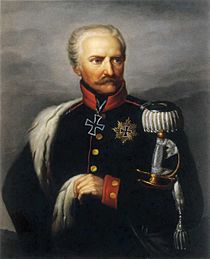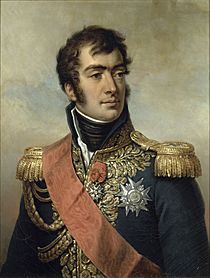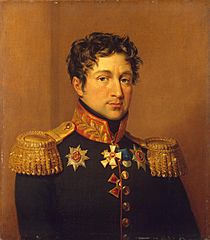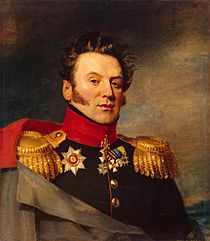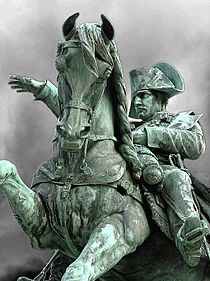Battle of Champaubert facts for kids
Quick facts for kids Battle of Champaubert |
|||||||
|---|---|---|---|---|---|---|---|
| Part of the Campaign of France of the Sixth Coalition | |||||||
 In the foreground, the French cuirassiers of General Doumerc. In the background, Marmont and Ney's infantry attack General Olsouviev's. |
|||||||
|
|||||||
| Belligerents | |||||||
| Commanders and leaders | |||||||
| Strength | |||||||
| 5,000 | 4,000 24 guns |
||||||
| Casualties and losses | |||||||
| 600 | 2,400 9 guns lost |
||||||
The Battle of Champaubert happened on February 10, 1814. It was the first big fight of the Six Days' Campaign. This battle was between the French army, led by Emperor Napoleon, and a smaller Russian army group. The Russian group was commanded by Lieutenant General Zakhar Dmitrievich Olsufiev. The Russians fought hard, but their forces were mostly destroyed. The few who survived ran into the nearby woods. General Olsufiev himself was captured by the French. Champaubert is a village in France, about 46 kilometers (29 miles) west of Châlons-en-Champagne. It is also about 69 kilometers (43 miles) east of Meaux.
Nine days before this battle, Napoleon lost to the Allies at the Battle of La Rothière. After this, the two main Allied armies split up. One army was led by Austrian Field Marshal Karl Philipp, Prince of Schwarzenberg. The other was led by Prussian field marshal Gebhard Leberecht von Blücher. Schwarzenberg's army moved slowly south. Blücher's army, however, was a bigger threat to Paris. Napoleon left some of his troops to keep Schwarzenberg busy. He then gathered 30,000 soldiers to deal with Blücher. Blücher had 57,000 men, but he let his army spread out too much. The Allies also had problems communicating. Blücher was too confident, which left Olsufiev's small group of soldiers alone near Champaubert. Napoleon's army then quickly attacked them, causing a huge defeat.
Contents
Setting the Scene for Battle
Allied Armies Spread Out
On February 1, 1814, Field Marshal Gebhard Leberecht von Blücher and Field Marshal Karl Philipp, Prince of Schwarzenberg defeated Napoleon. This happened at the Battle of La Rothière. Blücher had 80,000 Allied troops, and Schwarzenberg had his own army. Napoleon had 45,000 French soldiers. Both sides lost about 6,000 men. But the Allies also captured 50 to 60 French cannons. The Allies were happy with their win. However, they might have won even more if they had used all their backup troops. After this, the Allied generals made a risky choice to split their armies. Blücher's army would march from Châlons-sur-Marne towards Meaux. Schwarzenberg's army would take a more southern path from Troyes towards Paris.
On February 3, Napoleon's army reached Troyes. They had lost contact with the Allies the day before. On February 4, Schwarzenberg wrote to Blücher. He said he was moving further south. This was to try and get around Napoleon's right side. The next day, Russian General Michael Andreas Barclay de Tolly moved a scouting group. This group was from Schwarzenberg's right side to his left. But he did not tell Blücher. Blücher did not have an officer with this group. So, he did not know that no one was watching for French forces on his left side. Also on February 5, Napoleon decided to leave Troyes. He planned to fall back to Nogent-sur-Seine. His plan was to keep Schwarzenberg busy with some of his army. Then he would attack Blücher.
Schwarzenberg had planned a big attack on Troyes. But on February 7, he found no French troops there. He decided to let his soldiers rest for two days. Meanwhile, Napoleon reorganized his cavalry (horse soldiers). He created new cavalry groups. He also formed a new VII Corps (a large army unit). This corps was made of two divisions (smaller army units) from the Spanish front. Marshal Nicolas Oudinot was put in charge of it.
At the end of January, a French army group arrived from the north. It had 10,000 to 11,000 men. Marshal Jacques MacDonald led it. Blücher thought Schwarzenberg's moves would pull Napoleon away. So, he focused on destroying MacDonald's group. In the first week of February, Blücher ordered Ludwig Yorck von Wartenburg's group to chase MacDonald. They followed the main road in the Marne River valley. Blücher also sent Fabian Gottlieb von Osten-Sacken's group on a more direct road. This was through Montmirail and La Ferté-sous-Jouarre. He hoped to trap the French group. Blücher also waited for new groups to catch up. These were led by Peter Mikhailovich Kaptzevich and Friedrich von Kleist. Blücher used Zakhar Dmitrievich Olsufiev's small group. This group was meant to connect the two parts of his army.
On February 8, Sacken's cavalry reached Viels-Maisons. His foot soldiers were east at Montmirail. Olsufiev's group was 12 miles (19 km) further east at Étoges. Blücher set up his main camp 9 miles (14 km) further east at Vertus. Kaptzevich and Kleist were 16 miles (26 km) east of Blücher. Yorck's group was in the Marne valley, at least 12 miles (19 km) to the north. Bad roads separated them. Blücher's army was now spread out over 44 miles (71 km). Blücher thought Seslavin would report any danger from the south. That night, Sacken's Cossacks (Russian horsemen) were pushed out of Sézanne. Sacken did not tell Blücher about it. This was actually Napoleon's main group, led by Marshal Auguste de Marmont.
Napoleon's Surprise Attack
Napoleon left 39,000 soldiers to keep Schwarzenberg's army busy. These included Oudinot's VII Corps and Marshal Claude Perrin Victor's II Corps. Napoleon's main attacking force had about 20,000 foot soldiers and 10,000 horsemen. Another source said the French army had 30,000 men and 120 cannons. This army included Marshal Michel Ney's two Young Guard infantry divisions and Marmont's VI Corps. It also had parts of the Imperial Guard cavalry. Marshal Édouard Mortier, duc de Trévise was at Nogent with two Old Guard infantry divisions.
On February 9, MacDonald crossed the Marne River at La Ferté-sous-Jouarre. He was just ahead of Sacken. That day, Kaptzevich and Kleist met Blücher at Vertus. Olsufiev marched west to Champaubert. Sacken reached La Ferté-sous-Jouarre. Yorck was at Château-Thierry. Blücher's staff said his army had 57,000 men. This included Sacken's 20,000, Yorck's 18,000, and 19,000 from Kaptzevich, Olsufiev, and Kleist combined. Marmont's cavalry appeared at Talus-Saint-Prix. But they soon left. So, Blücher's chief of staff, August Neidhardt von Gneisenau, thought they were not a threat. Schwarzenberg asked Blücher for help. He wanted support for his right side, led by Peter Wittgenstein. Blücher ordered Kaptzevich and Kleist to march southwest to Sézanne the next day. Olsufiev was told to march south from Champaubert. That night, Blücher finally heard that Napoleon was at Sézanne. Still, Gneisenau let Sacken keep chasing MacDonald to the west.
Napoleon's soldiers walked on roads that were very muddy from days of rain. The men were hungry because food wagons could not get through. The heavy cannons got stuck in the mud. Local people helped pull the cannons forward. At first, the French people had accepted the Allied invasion. But after suffering from the Russians and Prussians, they wanted to help their own army. On February 10, Blücher was with Kaptzevich and Kleist. As they marched towards Sézanne, they heard cannons rumbling. The sound came from near Champaubert.
The Battle of Champaubert
The Fight Begins
On February 10, Napoleon attacked Blücher's spread-out army. He hoped to crush it. He found Olsufiev's IX Corps of 5,000 Russians near the village of Baye. This was just south of Champaubert. In this battle, France had a huge advantage in numbers, six to one. Olsufiev had planned to march south to Sézanne that day. He left the Saint-Prix bridge over the Petit Morin River untouched. He also left it unguarded. So, Napoleon's cavalry quickly took it in the morning. Marmont's two VI Corps divisions led the French column. Joseph Lagrange's 3rd Division crossed the Saint-Prix bridge. Étienne Pierre Sylvestre Ricard's 8th Division followed. Napoleon had given instructions. So, 100 Guard Dragoons rode ahead into Bannay. There, they surprised and captured some Russian soldiers.
Olsufiev's guards were quickly defeated by 10:00 am. Even though he was greatly outnumbered, the Russian general decided to fight. He hoped that Blücher would send help in time. The smart move would have been to retreat east to Étoges. But Olsufiev had been criticized before. He was blamed for losing a château at the Battle of Brienne on January 29. He was also blamed for handling his troops badly at La Rothière. Sacken even wanted him to face a court-martial (military trial). So, Olsufiev chose to fight to clear his name. He did send messengers to Blücher. He told his commander what was happening. But Blücher ignored Olsufiev's messages. He insisted that Napoleon was not there. He thought the attackers were only about 2,000 French rebels.
Lagrange's division moved left towards Bannay. It was led by the 2nd Light Infantry Regiment. Ricard's division marched straight towards Baye. Olsufiev sent Evstafi Evstafievich Udom with two jäger infantry battalions. Their job was to push the French skirmishers (lightly armed soldiers) out of Baye. As the French attacked more, Udom got more troops. He had the 10th, 12th, 22nd, and 38th Jäger Regiments and six cannons. Around 11:00 am, Ricard pushed Udom's troops back into Baye and the nearby woods. Olsufiev sent a brigade (a group of soldiers) and six cannons to hold the right side. Most of his army was between Baye and Bannay. The French brought 12 cannons into action. More and more French soldiers crossed the bridge and joined the fight. Pierre Pelleport's brigade led Lagrange's division as it attacked Bannay. At 1:00 pm, Olsufiev was still holding his position. At that time, the Russian commander held a council of war (a meeting of generals). His generals voted to retreat to Étoges. But Olsufiev refused. He said he had clear orders to hold Champaubert.
Marmont saw that a small wood was key to the position. He ordered a big attack. He sent the 113th Line Infantry forward. They were spread out as skirmishers. Ricard's division captured Baye. They were helped by horse artillery (cannons pulled by horses) and a lancer squadron (horse soldiers with spears). Lagrange attacked between Baye and Bannay. Ney's divisions started to arrive. Their cannons fired on Bannay. Bordesoulle's cavalry on the right and Jean-Pierre Doumerc's on the left began to move around the Russian sides. The 7th Battalion of the 4th Light Infantry were the first French troops to take Baye. Pelleport's brigade took Bannay. Olsufiev pulled back. He set up a new line at the Andecy Farm. As French cavalry began to surround both sides, the Russians pulled back again towards Champaubert.
The land on the west side favored the French. So, Lagrange attacked there. Without enough cannon support, the French foot soldiers were stopped. They were pushed back by 24 Russian cannons firing together. Many French Guard cannons, slowed by the mud, soon arrived. They gave Lagrange's men a place to gather and fight again. Doumerc's horsemen appeared at Fromentières. This was on the highway west of Champaubert. They had taken a longer route. Olsufiev heard that the road east to Châlons was also blocked. He decided to fight his way out in that direction. The Russian commander told Prince Konstantin Poltoratsky to hold Champaubert. Poltoratsky had two infantry regiments and nine cannons. Olsufiev would attack east towards Étoges with most of his troops. But Olsufiev's attempt to break out failed.
Poltoratsky's brigade had its cannons at the Champaubert crossroads. They drove off several cavalry charges. Ricard's soldiers fought fiercely with bayonets and captured the village. They lost it to a counterattack. Then they fought their way back into some houses. Olsufiev's main group failed to force its way to Étoges. So, it turned north to try and escape. Near La Caure, Olsufiev made a mistake. He exposed one of his sides while trying to enter a swampy forest. Marmont saw this and ordered a charge. A brigade of Bordesoulle's cuirassiers (heavy cavalry) crashed into the Russian group. They cut it in two. The Russian foot soldiers were completely defeated. Some threw away their guns and bags as they ran into the woods. Marmont ordered the exits blocked. Many Russians were captured. Udom and another commander, Peter Yakovlevich Kornilov, managed to escape. They got away with 1,500 to 2,000 men. That night, they reached Port-à-Binson on the Marne. They had traveled across the countryside. A 19-year-old French soldier, who had been in the army for less than six months, captured Olsufiev.
What Happened Next
Historians say the French lost about 600 soldiers killed or wounded. They had about 13,300 foot soldiers and 1,700 horsemen in the battle. The Russians lost 2,400 men and nine cannons. They had 3,700 soldiers and 24 cannons. Among those captured were Lieutenant General Olsufiev and Major General Prince Konstantin Poltoratsky. Some sources say Russian losses were 1,400 dead and 1,894 captured. This included three generals and 21 cannons. About 1,900 Russian troops escaped. French losses were estimated at 200 to 600. Another historian said French losses were only about 200 men. He also said only 1,000 out of 5,000 Russians escaped death or capture. Kornilov took command of the remaining IX Corps. Its roughly 1,500 survivors were put into three or four temporary groups. This unlucky group suffered 600 more losses and lost all their cannons at the Battle of Vauchamps on February 14.
When Blücher heard about Olsufiev's defeat, he ordered Kaptzevich and Kleist to turn around. They had to march back to Vertus during the night. Sacken, who had marched west to Trilport, was told to return to Montmirail. Yorck was asked to meet Sacken near Montmirail. He also had to keep an escape route open over the Marne at Château-Thierry. After the battle, Napoleon was right in the middle of Blücher's spread-out army. If he went east, he would just push Kaptzevich and Kleist back. But if he moved west, he might trap and destroy Sacken and Yorck's forces. So, he turned west. Napoleon ordered Marmont to hold Étoges. Marmont had Lagrange's division and the I Cavalry Corps. Their job was to watch Blücher. At 7:00 pm, the emperor told Étienne Marie Antoine Champion de Nansouty to take two cavalry divisions to Montmirail. Ricard's division and the divisions under Ney and Mortier were to join them there in the morning. The Battle of Montmirail was fought the next day against Sacken and Yorck.


